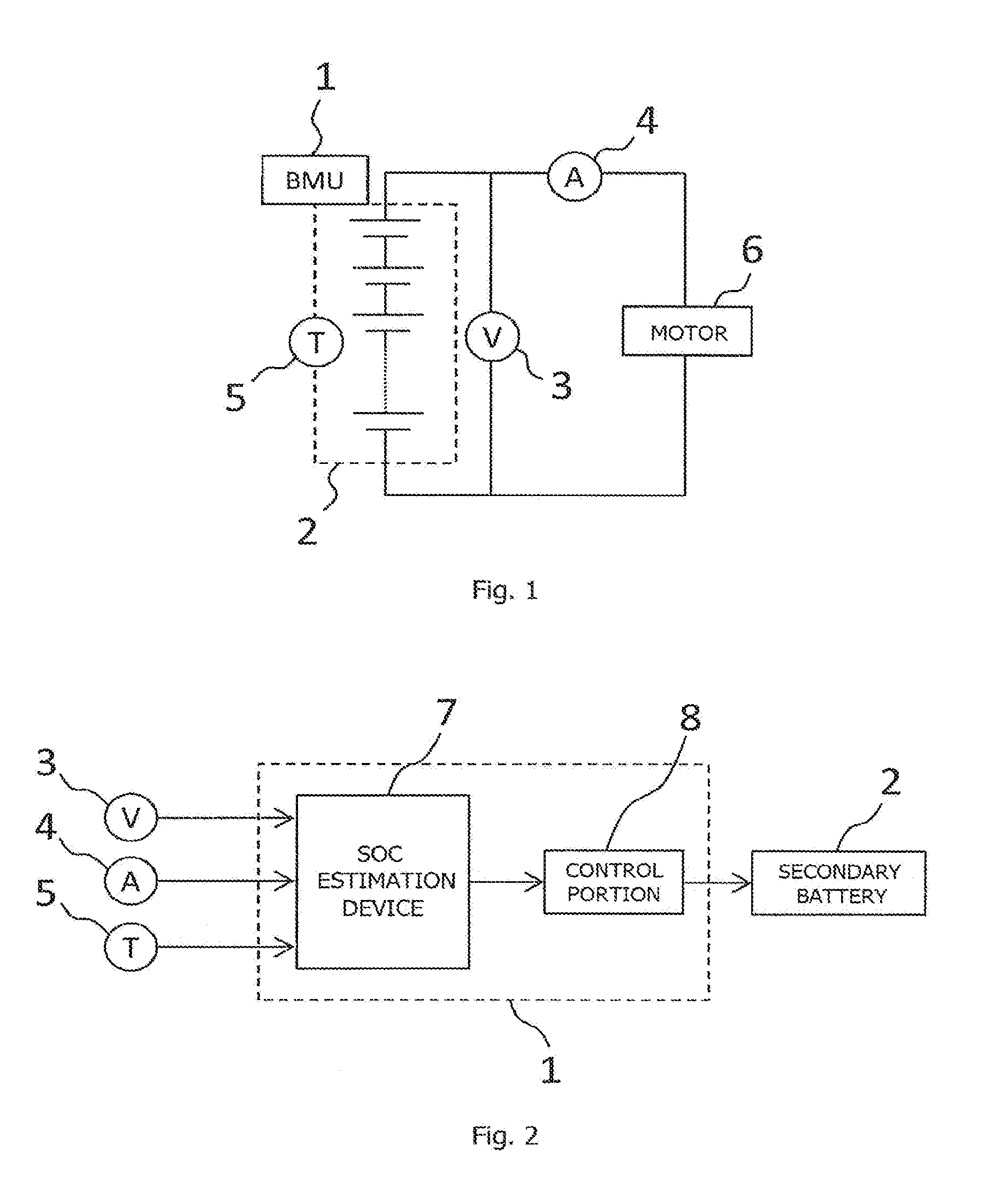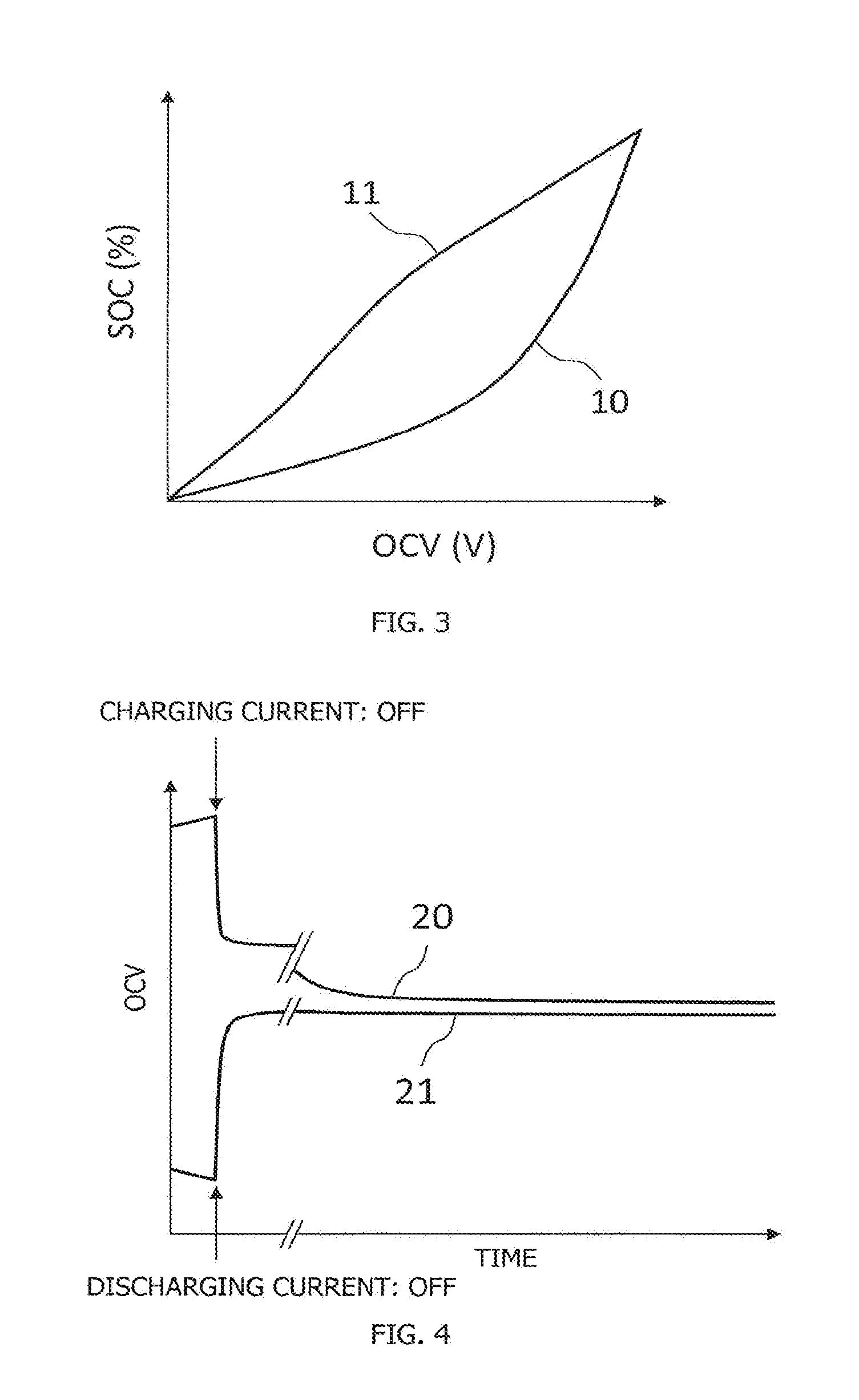Soc estimation device for secondary battery
a secondary battery and estimation device technology, applied in circuit monitoring/indication, lamps testing, instruments, etc., can solve the problems of disadvantageous expansion or increase in temperature of secondary batteries, disadvantageous inability to accurately estimate soc from actual measured ocv, etc., to achieve accurate estimation of soc
- Summary
- Abstract
- Description
- Claims
- Application Information
AI Technical Summary
Benefits of technology
Problems solved by technology
Method used
Image
Examples
first embodiment
[0029]FIG. 1 is a diagram showing the configuration of a secondary battery system which includes the SOC estimation device for the secondary battery according to the present invention. As shown in FIG. 1, the secondary battery system includes a BMU (Battery Management Unit) 1 which performs control on the secondary battery 2, the secondary battery 2, a voltage sensor 3 which measures a voltage between terminals in the secondary battery 2, a current sensor 4 which measures an energizing current and a temperature sensor 5 which measures a battery temperature, and is connected to a motor 6 which consumes the power of the secondary battery 2 or regenerates the power of the secondary battery 2. In this configuration, the BMU 1 includes the SOC estimation device of the present invention. Although not shown in the figure, in the secondary battery system, between the secondary battery 2 and the motor 6, a converter which steps the voltage of the secondary battery 2 up and down, an inverter ...
second embodiment
[0053]In the present embodiment, a description will be given of the SOC estimation device 7 of the secondary battery 2 using relational formula 12 in which the accuracy of the estimation of the SOC is enhanced by further adding, to the relational formula 12 of the first embodiment, conditions on which an actual event in the secondary battery 2 is reflected.
[0054]FIG. 8 is a graph showing a correlation curve indicating a relationship between a charge amount Q and an OCV in the secondary battery 2 in which the correlation curve indicating the relationship between the SOC and the OCV differs between the charging process and the discharging process. As shown in FIG. 8, when the secondary battery 2 is charged, as the OCV is increased, the charge amount Q is increased according to a correlation curve 13 indicating a relationship between the charge amount Q and the OCV in the charging process. In contrast, when the secondary battery 2 is discharged, as the OCV is lowered, the charge amount...
third embodiment
[0064]The present embodiment differs from the first and second embodiments in that the SOC is estimated using the relational formula 12 in which weights are assigned according to the magnitude of an SOC calculated from a charge amount obtained by summing charging current and discharging current in the secondary battery (hereinafter referred to as a “calculated SOC”).
[0065]Specifically, in the SOC estimation device 7 of the secondary battery 2 according to the present embodiment, the relational formula is used in which as the calculated SOC is higher, weights are assigned to the correlation curve 11 indicating the relationship between the SOC and the OCV in the discharging process and as the calculated SOC is lower, weights are assigned to the correlation curve 10 indicating the relationship between the SOC and the OCV in the charging process. As with the actually measured OCV, according to the magnitude of the calculated SOC, there is a greater tendency for the calculated SOC to fol...
PUM
 Login to View More
Login to View More Abstract
Description
Claims
Application Information
 Login to View More
Login to View More - R&D
- Intellectual Property
- Life Sciences
- Materials
- Tech Scout
- Unparalleled Data Quality
- Higher Quality Content
- 60% Fewer Hallucinations
Browse by: Latest US Patents, China's latest patents, Technical Efficacy Thesaurus, Application Domain, Technology Topic, Popular Technical Reports.
© 2025 PatSnap. All rights reserved.Legal|Privacy policy|Modern Slavery Act Transparency Statement|Sitemap|About US| Contact US: help@patsnap.com



